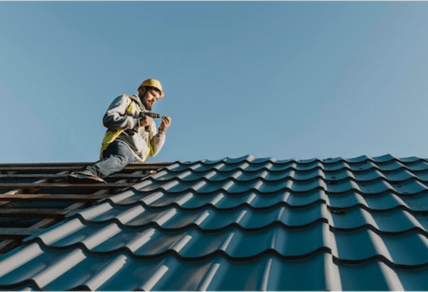A roof is one of the most critical components of your home, safeguarding you from the elements and ensuring structural integrity. However, roofs are exposed to harsh conditions that can lead to wear and tear over time. Extending the lifespan of your roof requires regular maintenance, timely repairs, and preventive measures. This comprehensive guide explores practical strategies and tips to help you maximize the durability and longevity of your roof, ensuring it remains in excellent condition for years to come.
1. Regular Inspections and Maintenance
Routine inspections and maintenance are essential for identifying potential issues before they become major problems. Here’s how to stay on top of roof care:
Schedule Annual Inspections
Arrange for a professional roof inspection at least once a year. An experienced roofer can detect signs of damage, wear, and deterioration that may not be visible to the untrained eye. Inspections should also be conducted after severe weather events, such as storms or heavy snowfall, to assess any damage.
Clean Gutters and Downspouts
Clogged gutters and downspouts can cause water to back up and damage your roof. Regularly clean gutters and downspouts to ensure proper drainage and prevent water from pooling on your roof. Consider installing gutter guards to reduce the frequency of cleaning and keep debris out.
Trim Overhanging Trees
Trees with overhanging branches can cause damage to your roof by dropping leaves, branches, or sap. Trim branches that are close to your roof to prevent potential damage and reduce the risk of debris accumulation. Keeping trees well-maintained also minimizes the chances of branches falling during storms.
2. Addressing Common Roof Issues Promptly
Timely repairs are crucial for extending the lifespan of your roof. Ignoring minor issues can lead to more significant problems and costly repairs. Here are common roof issues to watch for and address promptly:
Leaks and Water Damage
Leaks are a serious concern that can lead to extensive water damage and mold growth. Inspect your roof regularly for signs of leaks, such as water stains on the ceiling or walls. If you notice any leaks, contact a professional roofer immediately to identify the source and perform necessary repairs.
Missing or Damaged Shingles
Missing or damaged shingles compromise the integrity of your roof and can lead to leaks. Check for cracked, curled, or missing shingles and replace them as soon as possible. Addressing damaged shingles promptly prevents further deterioration and protects your home from the elements.
Roof Ventilation Issues
Proper roof ventilation is essential for regulating temperature and moisture levels in your attic. Poor ventilation can lead to heat buildup and condensation, causing damage to your roof and insulation. Ensure that your roof has adequate ventilation and inspect vents regularly for obstructions or damage.
3. Choosing the Right Roofing Materials
The choice of roofing materials can impact the lifespan and durability of your roof. When selecting materials, consider the following factors:
Opt for High-Quality Materials
Investing in high-quality roofing materials can significantly extend the lifespan of your roof. Premium materials, such as asphalt shingles, metal roofing, and clay tiles, offer better durability and performance compared to lower-quality options. Consult with a roofing professional to choose materials that suit your climate and budget.
Consider Climate and Weather Conditions
Different roofing materials perform better in specific climates. For example, metal roofs are highly resistant to extreme weather conditions and are ideal for areas prone to heavy snow or hail. Asphalt shingles are versatile and suitable for a variety of climates. Choose materials that match your local weather conditions for optimal performance.
Professional Installation
Proper installation is crucial for ensuring the longevity of your roof. Hire a licensed and experienced roofing contractor to perform the installation. Professional installation ensures that materials are applied correctly and that the roof meets industry standards and building codes.
4. Proper Attic Insulation and Ventilation
Attic insulation and ventilation play a significant role in maintaining the health of your roof. Proper insulation and ventilation help regulate temperature and moisture levels, preventing damage to your roof and extending its lifespan.
Insulate Your Attic
Adequate attic insulation helps maintain a consistent temperature in your home and reduces the risk of ice dams forming on your roof. Proper insulation also improves energy efficiency and lowers heating and cooling costs. Ensure that your attic is insulated to prevent heat transfer and protect your roof from temperature extremes.
Ensure Proper Ventilation
Proper attic ventilation allows moisture and heat to escape, preventing condensation and ice dams. Install soffit vents, ridge vents, and gable vents to promote airflow and maintain a balanced ventilation system. Proper ventilation helps prevent roof damage and extends the lifespan of your roofing materials.
5. Preventive Measures and Upgrades
Taking preventive measures and making upgrades can enhance the durability and performance of your roof. Consider the following strategies to protect and extend the life of your roof:
Apply a Roof Coating
Roof coatings provide an extra layer of protection against UV rays, weathering, and water damage. Reflective roof coatings can also improve energy efficiency by reducing heat absorption. Consult with a roofing professional to determine if a roof coating is suitable for your roofing material and climate.
Install Impact-Resistant Roofing
If you live in an area prone to severe weather, consider upgrading to impact-resistant roofing materials. Impact-resistant shingles and metal roofing are designed to withstand hail, falling debris, and high winds. These materials offer enhanced protection and can extend the lifespan of your roof.
Upgrade Flashing and Seals
Flashing and seals are critical components that prevent water from penetrating your roof. Upgrade or replace damaged flashing and seals around chimneys, skylights, and vents to ensure a watertight seal. Proper flashing installation and maintenance help prevent leaks and prolong the life of your roof.
6. Protecting Your Roof During Extreme Weather
Extreme weather conditions can put additional stress on your roof. Taking precautions during severe weather events can help protect your roof and minimize potential damage.
Prepare for Storms
Before a storm hits, inspect your roof for any vulnerabilities, such as loose shingles or damaged flashing. Secure or remove any loose objects from your yard that could become projectiles. Consider installing impact-resistant roofing materials or reinforcing your roof if you live in a storm-prone area.
Snow and Ice Management
In regions with heavy snowfall, managing snow and ice buildup is essential for preventing roof damage. Remove snow from your roof using a roof rake with a long handle, being careful not to damage the shingles. Prevent ice dams by ensuring proper attic insulation and ventilation to keep the roof surface warm.
Emergency Repairs
In the event of significant roof damage, such as after a severe storm, make temporary repairs to prevent further damage. Use a tarp or plastic sheeting to cover exposed areas until professional repairs can be made. Contact a roofing contractor as soon as possible to assess and address the damage.
7. Regular Roof Cleaning
Regular roof cleaning helps maintain the appearance and functionality of your roof. Cleaning removes debris, algae, and moss that can contribute to roof deterioration.
Remove Debris
Clear leaves, branches, and other debris from your roof and gutters regularly. Debris can trap moisture, leading to mold growth and deterioration. Use a soft-bristle broom or leaf blower to safely remove debris without damaging the roofing material.
Address Algae and Moss
Algae and moss can grow on roofs, especially in shaded or humid areas. These growths can cause roofing materials to deteriorate over time. Use a gentle roof cleaner or a mixture of water and bleach to remove algae and moss. Avoid using harsh chemicals or pressure washing, which can damage the roof.
8. Long-Term Roof Care
Long-term care is essential for maintaining the health and longevity of your roof. Implement these practices to ensure ongoing protection and performance.
Keep Records of Maintenance and Repairs
Maintain detailed records of all roof maintenance and repairs. Document inspections, repairs, and any upgrades or improvements made to the roof. Keeping accurate records helps track the roof’s condition and ensures that you address any issues promptly.
Plan for Future Upgrades
As your roof ages, consider planning for future upgrades or replacement. Monitor the condition of your roof and consult with a roofing professional to determine when it may be time for a replacement. Planning ahead helps you budget for future expenses and ensures that you make informed decisions about your roof’s care.
Conclusion
Extending the lifespan of your roof requires proactive maintenance, timely repairs, and preventive measures. By following the strategies outlined in this guide, you can protect your roof from damage, enhance its durability, and ensure that it continues to provide reliable protection for your home. Regular inspections, addressing common issues, choosing high-quality materials, and implementing preventive measures are key to maintaining a healthy and long-lasting roof. With proper care and attention, you can extend the life of your roof and enjoy peace of mind knowing that your home is well-protected.


